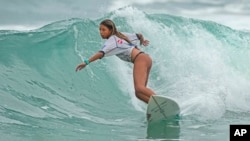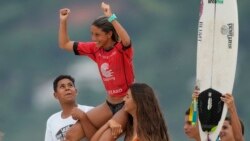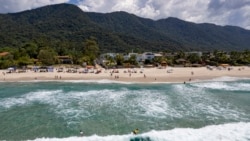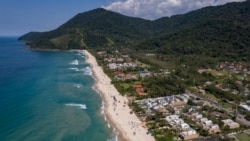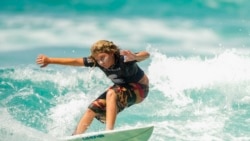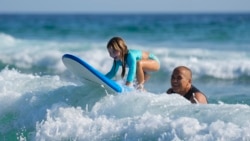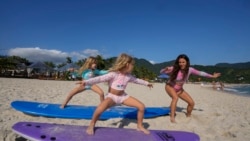As most of Brazil tuned in to watch two local clubs battle for the continent's soccer championship last month, 14-year-old Luana Reis was far from a television set.
She was surfing blue-green waves with a soaring rainforest backdrop, competing with dozens of other teens in the yearly municipal tournament at one of the country's premier surf beaches, Maresias.
She deployed snaps, cutbacks and aerials to win the under-18 women's title and then emerged from the water sitting atop the shoulders of four friends, mimicking her idol, Gabriel Medina — a world champion raised at Maresias who has helped make Brazil's surfers as admired as its soccer stars worldwide.
Next year, Reis said, she aims to contend for the national under-18 women's championship.
"Everyone here dreams of being the next great surfer from Brazil," Reis told The Associated Press. "There's a lot of competition, especially here in Maresias. Doing it here is hard."
The beach in the town of Sao Sebastiao is ground zero for surfing in a nation that unleashed "the Brazilian Storm" on the world — a generation of professional surfers who have won five of the past seven men's world championships.
Many came into their own along a 200-kilometer (120-mile) stretch of shoreline in Sao Paulo state. Reis' parents moved here largely so she could train every day.
Medina, 28, has led that crusade, winning three world championships – a feat accomplished by only four others since the modern surfing league began in 1983.
At one moment in this year's championship heat in San Clemente, California, Medina snagged a small, clean peak and veered his board to the left as he popped to his feet. He watched patiently as the wave walled up, then completed a few turns while casually throwing in a few air reverses along the way.
He "turns a mediocre wave into something of substance," said television commentator Mick Fanning, himself a three-time champion. "That first air was incredible."
When the buzzer sounded, sealing Medina's victory, runner-up Filipe Toledo paddled over to offer a congratulatory hug. The two grew up surfing the same waves, with Toledo's home just up the coast, in Ubatuba. Third place went to another Brazilian, 2019 world champ and gold medallist in the Tokyo Olympics, Italo Ferreira.
Sao Paulo state's string of North Shore beaches were relatively unknown before Medina put Maresias on the professional surfing map with his first world title in 2014, and he lifted the trophy again in 2018.
Speaking to the AP by phone, Medina said Maresias' simple lifestyle is an asset for surfers.
"We don't have any tall buildings here. It is just houses, beaches and a lot of nature," Medina said. "I travel all over the world, but I still value the place where I live, where I came from. I feel complete here. This place gives me peace and ease to do everything I'm able to do."
The surf towns dotting the coastline are inside the Serra do Mar park, which the state says is Brazil's largest continuous protected area of Atlantic Forest. It acts as a barrier to the urban sprawl of metropolitan Sao Paulo. Thick forest blankets rugged mountains and valleys, where waterfall pools drain into streams that wind through mangroves before emptying into an emerald sea.
The area's waves went virtually unridden until construction in the 1970s of a coastal highway, which surfing trailblazers followed to explore.
"Back in the 1980s, there were just a few of us; this was an isolated region of the coast," said 58-year-old Adriano Garcia, a fisherman born in Sao Sebastiao who has surfed for four decades. "The championships started, surfers from here became dominant and -- boom!"
When Frank Constâncio started organizing competitions in 1985, he had to fill many roles himself – from security guard to referee to commentator.
"Years ago, only açai and surfwear brands would sponsor events here. Now there's real estate developers and banks," said Constâncio, who is president of the Sao Sebastiao Surfers' Association.
Today, hotels and restaurants are plastered with pictures of local legends, particularly Medina, who also features on billboards promoting a television manufacturer, phone carrier, dental services provider and an automaker.
"Medina is only one of the surfers who came from this (municipal) tournament," Constâncio said, surveying the competitors in the water. "The next Medina could be here today."
Henrique Tricca, an Ubatuba-based surf photographer, competed along the North Shore in the 1990s and 2000s and went on to win contests in Europe. He said Sao Paulo's surf associations helped develop local pros. They were the first in Brazil to organize competitions with live electronic scoring and a running clock that surfers could see from the water.
The waves were another factor.
"They're far from perfect," Tricca stated as he pulled his head back from his camera and grinned, pointing to a man attempting to enter a wave's barrel but instead getting swallowed in an explosion of white water.
"Being mostly beach breaks, the waves break faster and hollower here. It's hard to know which waves to choose and where to paddle into them. The swells come from the south, the southeast, the east and sometimes all three directions at the same time. On top of that, the tide changes and the sandbars move, so every day and even every hour it's like surfing a completely different wave."
Such irregularity paired with consistent swells during the peak season, from May to November, makes the coast hallowed training ground.
Though most waves break only 1 to 3 meters high (up to about 10 feet), they offer all kinds of conditions. So the world-class waves of international competitions — typically more perfect, predictable reef and point breaks — are easier to read and ride for natives of Sao Sebastiao and nearby towns.
Medina said his early days at the municipal championship were key to his success.
"The truth is I had more defeats than victories in my childhood," Medina said. "At first, I just had fun surfing. Then I fell in love with the sport, and only then did I start competing. Every time I lost here, I was very upset. In the beginning, you dream about winning, going professional, being a world champion. But it didn't happen just like that."
Several other North Shore towns have representatives in the Brazilian Storm, from Guaruja's Adriano de Souza and Caio Ibele to Ubatuba's Toledo and Wiggolly Dantas.
Eduardo Tanimoto, 52, is one of the originals. A native of Sao Paulo's countryside, he started surfing at Sao Sebastiao when the sport revolved around lifestyle rather than competition. His daughter, Rayana Tanimoto, caught the surfing bug from him
Together, they opened a small hotel on Maresias beach so she could raise her 5-year-old twin daughters, make a living and get in the water as often as possible.
"There are other places where you see surfers and the Atlantic Forest sort of merge, but here is special," she said
Sipping on a glass of passion fruit juice at the reception desk and looking at the surfboards resting against her hotel's entrance, Rayana Tanimoto said Maresias and surfing have strengthened her family's bonds. Earlier in the day, she and her twins were catching waves, the girls taking turns standing on the board with their mom. Someday soon, her girls hope to enter competitions.
It was early evening, with the moon showing above the lush mountainside. The surfers would be back at it early the next morning before the wind kicked up.
"There aren't many places that allow you to connect with something bigger than yourself," she said. "For me, this is it."
